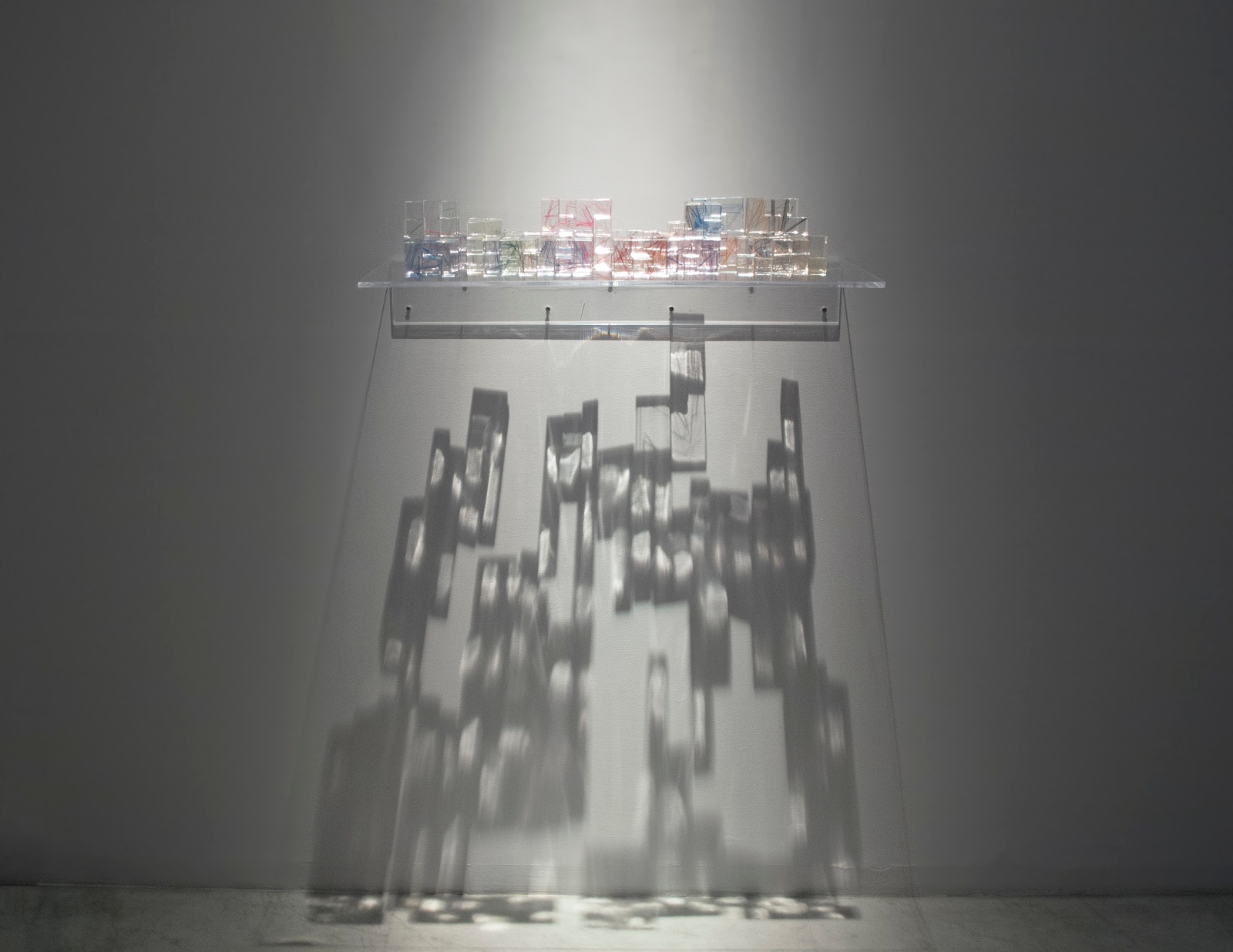
Just IN Just OUT, 2018
Acrylic on engraved acrylic
13 3/4″ x 30″ (Variable)
In 100 parts, Each 2″ x 2″ x 1″
Taking the line for a walk
New York city’s skyline or Mumbai’s showstopping Marine Drive, like a slew of high-rises, glittering like stars at night, is the first thought when the spotlight falls on artist Sheila Makhijani’s sculptural installation Just In Just Out. In vivid, peppy colours of pink, blue and yellow, they take centre stage in a room at Talwar Gallery, Delhi. Acrylic blocks, that look like transparent ice cubes become the canvas for the Delhi-based artist, who has needled her favourite accomplice — lines — on the surface of these cubes and filled the gaps with acrylic paint. Visitors are allowed to reassemble them, like children do with building blocks, to create their own artwork.
“Eventually I want everyone to be able to make their own drawings. People find drawing so difficult and complex. It is like thousands of construction blocks that we can keep changing and viewers can make their own work. These appear blue or pink but in reality these blocks are transparent and it is the colour which is reflecting,” says 57-year-old Makhijani,who has worked with light and refraction in this piece. Her latest solo “This, That and the Other” is an opportunity to glimpse into the modest work of the relatively quiet artist — 18 paintings, sculptural works and graffiti-like mural.
Makhijani’s piece Take a leap at Museum of Modern Art (MoMA)’s 2010 exhibition, “On Line: Drawing Through the Twentieth Century” explored the radical transformation of a line over a century. With the help of 300 works of numerous artists, it marked a remarkable, experimental departure from the traditional definition of a drawing. Speaking about the relationship she shares with lines, Makhijani says, “Everything is a line. There is a line around us, our hair has so many lines, so do our eyes. Lines are a part of us, whether we like it or not. There is so much power in it. The space in this gallery, even the shadows that fall, have lines. We see lines everywhere but it depends on how we interpret it.”
Spilled across the ground floor of the gallery is the artist’s installation All over the place from 1994, which she created in Netherlands. It is being showcased for the first time in India. A collection of colourful glazed and unglazed ceramic pieces appear like toys strewn around a play school. Tiny replicas of things that fascinate her and she can associate herself with, from a bridge and a canoe to a bench and a bed, make their way here. “I can be a small little person and live in this work. I can be a lilliput and live and do whatever I want. I can go boating, sit on a chair there, cross a bridge, sleep here. It’s like my own city, in a way, it’s like my own place where I could move all over,” says Makhijani, who has held solos at Talwar previously.
Having exhibited in Holland, Australia, and Uganda in the past and belonging to the first masters’ batch of College of Art in Delhi, where she graduated in 1988, Makhijani’s gouache on paper work This that and the other comprises a cluster of white canvases. Their central characters of small, swift brush strokes in red and blue, appear more like a bird spreading its wings and taking flight in numerous poses. Painted in a similar fashion, her acrylic on the facade of the gallery, titled Flying High, stands tall like a flag. She sees her lines like adults trying to manoeuver their way through life. Like a master trying to train them, Makhijani says, “These lines have a life of their own, they go wherever they want, sometimes they are wild and sometimes one has to tame them and bring them back. I see them as independent beings and they want to do their own thing, just like us as adults who want to do their own thing in life.”
Her canvases like So much for now and How was I to know appear like a cloud of dark and bright colours.
The titles come up before Makhijani exhibits her work and whatever comes to her mind when she sees them. “There is a lot of confusion on the canvas, just like a lot of confusion in the mind. I want the canvas to have its own life. I get so carried away with line and colour. For instance, even if I want to paint someone, I can never make them exactly the way they are. They take their own form.”
-Pallavi Chattopadhay